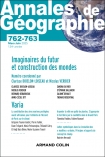
ANNALES DE GÉOGRAPHIE N° 762-763 (2-3/2025)
Pour acheter ce numéro, contactez-nous
Recevez les numéros de l'année en cours et accédez à l'intégralité des articles en ligne.
Les enfants sont affectés quotidiennement, quoiqu’inégalement, par des processus socio-spatiaux globalisés, mais leurs propres perspectives sur les enjeux globaux restent peu étudiées. À partir d’une enquête menée auprès de 248 enfants âgés de 6 à 11 ans dans quatre écoles élémentaires parisiennes aux profils sociaux contrastés, la recherche présentée dans cet article a permis d’analyser comment les enfants représentent le monde et de retracer la genèse sociale des représentations de l’espace mondial dans l’enfance. J’ai déployé sur le terrain un dispositif pluriméthodologique composé de quatre activités (dessin, brainstorming, reconstitution d’un planisphère illustré, entretiens en petits groupes), auquel j’ai associé un travail d’observation dans les classes, d’entretiens auprès des enseignants et d’analyse de supports pédagogiques. L’article interroge la construction des représentations enfantines de l’espacemondial, en insistant sur les temporalités qui les influencent, entre poids des héritages et importance des imaginaires du futur. Il explore la socialisation différenciée des enfants aux enjeux globaux et souligne que l’inégale socialisation des enfants au monde crée et renforce des rapports de domination structurant le monde social.
Children are affected on a daily basis (albeit unevenly) by globalised sociospatial processes, but their own perspectives on global issues have rarely been studied. The research presented in this paper analysed how children portray the world and traced the social origins of representations of the global space in childhood. It is based on a field survey of 248 children aged 6 to 11 in four Parisian elementary schools with contrasting social profiles. I deployed a multimethodological approach, composed of four activities (commented drawing, brainstorming, reconstructing an illustrated map of the world, small-group interviews), combined with classroom observation, interviews with teachers and analysis of teaching materials. This article specifically examines the construction of children’s representations of the world, focusing on the temporalities that influence them, between the weight of legacies and the importance of imaginary futures. It explores the socialisation of children with respect to global issues and emphasises that the unequal socialisation of children around the world creates and reinforces the relationships of domination that structure the social world.

